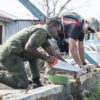New Zealand Chief of Army Writing Competition 22.1 Winner of the WO/SNCO Category.
TALENT NOT TENURE: THE CASE FOR MID-CAREER ENTRY IN THE NEW ZEALAND ARMY
By D. Kendon
By adhering to an outdated career model based on a single-lifelong career, the New Zealand Army is missing out on a huge pool of talent. Since the 1990s, for a variety of reasons, careers have become more varied. It is now common for people to change career within and between industries.1 However, apart from specialist officers, there is currently no way for mid-career individuals, who already have qualifications and experience, to join as a soldier or officer at a position that recognises their prior accomplishments – and starting at the bottom is not appealing for people who are likely to have families and mortgages. This essay will argue that the condition of service required to attract and sustain talent is mid-career entry. This would provide the Army with a talent pool that could not only fill immediate requirements for middle leaders, but also make the Army more agile, adaptable, and effective. It would also have second-order effects that would improve retention for all personnel.
The Problem
The Army needs more middle leaders. Attrition across all ranks was 10.6% last year. Op PROTECT was a factor in many separations, and the Chief of Army has estimated these losses will take two to three years to regenerate.2 However, the loss of middle leaders has a significantly larger impact than junior personnel, due to the current requirement for personnel to enter at the bottom.3 Corporals, sergeants and captains currently take five to six years to progress through training pipelines. While waiting for these personnel to develop, we can end up promoting personnel before they are ready, to the detriment of the individual, job standards, and quality of leadership. This requires significant effort to undo. Alternatively, lack of middle leaders can overburden junior personnel, leading to burnout and possible separation. This problem is occurring right now and cannot wait years.
Furthermore, Army’s current career model focuses selection of its entire workforce from the cohort of 18-24 year olds. If a person decides not to join at this age, and changes their mind later, they must start at the bottom. For a mid-career individual, who has already worked their way up to moderate pay rates, and likely has significant financial responsibilities, the prospect of lower pay for several years means joining the Army may not be financially sustainable. Furthermore, some conditions of service, such as not being trusted with a toaster, are not appealing to someone in their late 20s or 30s. These factors all mean that we are not able to select from the widest possible pool of talent, excluding people who already have valuable knowledge, skills and experience.
A Potential Solution
Mid-career entry offers a solution to this. Such a system would involve prospective recruits going through an entry selection process for a particular rank and trade, including assessment of their civilian qualifications and experience4, and suitability for Army life.5 We would then put them on an accelerated pipeline of required military coursing, before granting them a rank appropriate to their abilities and knowledge. Unlike similar proposals6, personnel would meet the same fitness and uniform standards as other personnel, and use existing progression models.
This is not as radical as it may appear. We already allow personnel with rank but no trade experience to transfer between trades, in most cases with accelerated coursing to gain the qualifications required for the rank at which they transferred. We already have selection boards and intensive training for personnel suitable to take leadership positions from the start of their career with the Army – the Officer Selection Board and the New Zealand Commissioning Course. Mid-career entry is not a big step from what we already do.
In order for the system to work, the prospect of mid-career entry must be attractive to an outsider.7 Pay rates are important – a person at mid-career is likely to have financial commitments such as a mortgage – but they are not the only factor. The Army can offer much to someone seeking a change, such as new situations in which to use their existing skills, unique work environments, and new opportunities for personal growth, all while serving their country.8
This scheme is clearly not suitable for all corps and trades, or for all types of applicant, and we should be strategic in its application.9 Initially, it could start with roles where specialist knowledge and skills are more important than traditionally military skills. For example, certain engineering and logistics trades would be suitable, whereas infantry would not. Furthermore, we should not use this for every vacancy. External applicants should fill no more than one third of the vacancies, to maintain a majority with military experience.
Benefits
First, mid-career entry would increase the likelihood that people return to the Army. The ability to have their civilian qualifications and experience recognised, and return at a commensurate rank, would make returning more attractive. This would allow the Army to gain the benefit of their civilian experience, while also retaining the investment put into their training while in uniform.10
More important, bringing in personnel at higher ranks will encourage diverse thinking in planning and command, which are essential for success in the modern operational environment. Although the Army has progressed with some types of diversity, such as race, religion and sexual orientation, those who have spent their entire working life in uniform, and have progressed through similar training and experiences, are likely to have similar perspectives on problems. The diversity of thinking is limited.11 Those with significant experience outside the military can provide fresh perspectives and see things we have missed, because we did not even think to look for them.12 Additionally, introducing people who are less indoctrinated into doing things one way ‘because that’s how it’s always been done’ in the middle ranks will help make us more agile as an organisation. All wars are battles of adaptation – whoever can change and adapt the fastest will win.13 To be successful we will need true diversity, not people who look different but all think the same.
Challenges
Although those entering mid-career would not have as much experience with the Army as those who join young, we can bridge the skill and knowledge gap. Most of the skills that make someone successful in civilian life can be applied in the military. All organisations require leadership, teamwork, problem-solving, initiative, communications and organisational skills. Civilian organisations regularly plan and carry out large scale change – sometimes at a larger scale than the entire NZDF. Solving problems and getting things done with limited time, personnel and funding – is this describing an officer or an entrepreneur? It is important to recognise that the vast majority of the time we employ non-kinetic effects in situations short of war. Grey-zone conflict requires leaders who are masters of a spectrum from subtle influence to conflict.14 A lack of field time will not disadvantage achieving the outcomes we will need most of the time.
When we say we want experience, we need to be clear about what we expect that experience to provide – specific knowledge, skills and attitudes. If we rely on numbers of postings as a measure of military professionalism15, we lock ourselves into using 20-year careerists, and time in rank is no guarantee of competence.16 If there is so much that can only be learned on the job, and is not recorded elsewhere, there is a problem with our doctrine. We can train knowledge about the military and military applications; skills such as problem-solving and leadership are harder to develop.17
The ability for applicants to accept and be accepted by Army culture is a valid concern, but we can address this. First, we already have considerable experience instilling Army culture into civilians through the All Arms Recruit Course. Another key part of gaining acceptance is ensuring that everyone who wears a uniform meets the same fitness and uniform standards, so a lateral entry will gain respect from their peers. A preference for applicants with experience in similar organisations, such as the police, is another option. Lateral entries will need support and mentoring to assist them with the move from civilian to soldier, for up to two years.18 Onboarding a cohort as a group will likely be of assistance here, to give personnel a peer network, similar to a Basic or OCS class.19 There will likely be resentment of personnel who have not spent time in less-desirable postings. However, a mid-career entry has done their time – just not in the Army.
Second-Order Benefits
Introducing of mid-career entry would also provide second-order benefits to improve conditions for all soldiers. First, the recruitment process for mid-career entry would require clear measures of knowledge, skills and attitudes. In developing these, we can compare measures for promotion for all personnel against the civilian sector. By aligning progression with other employers, soldiers will be less likely to leave to seek opportunities for promotion. Secondly, the introduction of outsiders at higher ranks also offers the opportunity to shake up the negative aspects of Army culture. We still have issues with bullying, sexism, homophobia, and alcohol abuse.20 Advancing personnel with experience in workplaces where these are not the norm will likely assist with breaking some unhelpful attitudes. Third, the introduction of mid-career entry is an opportunity to critically examine conditions of service. Using the lens of how conditions would appear to a mid-career civilian will help identify areas that may need attention, across all aspects of Army life.
Conclusion
The Army is currently not an attractive prospect to a mid-career professional. This means that we are missing out on talent from the majority of the working-age population. Providing a pathway for mid-career individuals to enter at a rank commensurate with their qualifications and abilities would not only address immediate requirements to fill middle leadership positions, but would also provide the diversity of thinking to make us effective in future competition and conflict. Such a scheme would require careful integration, but we can overcome the challenges. But to do so, we must first change our thinking, and focus on talent, not tenure.
Footnotes:
1 Stephanie White, Antecedents and Outcomes of Personnel Perceptions of the Effectiveness of Career
Management Practices in the New Zealand Defence Force, Massey University, 2007, p.4.
2 https://www.stuff.co.nz/national/300463411/three-years-until-army-at-precovid-strength-as-miq-drives-military-resignations, accessed 17 Apr 22.
4 Peter Cappelli, ‘Your Approach to Hiring is All Wrong’, Harvard Business Review, May 2019.
5 https://axiomcp.com/idea/why-lateral-hiring-often-fails-and-why-yours-doesnt-have-to/, accessed 17 Apr 22; https://www.legalbusiness.co.uk/blogs/comment-a-triumph-of-hope-over-experience-lateral-hiring-needs-an-upgrade-for-the-post-covid-era/, accessed 17 Apr 22.
6 https://www.express.co.uk/news/world/826649/Army-recruit-senior-ranks-General-Sir-Nick-Carter-lateral-entry, accessed 17 Apr 22.
7 Partnership for Public Service, ‘Mid-Career Hiring: Revisiting the Search for Seasoned Talent in the Federal Government’, Sep 2004, p.11
8 Cappelli; https://www.mckinsey.com/business-functions/people-and-organizational-performance/our-insights/attracting-and-retaining-the-right-talent, accessed 10 Apr 22.
9 Partnership for Public Service, p. 13.
10 https://www.mckinsey.com/business-functions/people-and-organizational-performance/our-insights/the-organization-blog/the-great-attrition-what-to-do-about-the-labor-shortage, accessed 10 Apr 22.
11 https://wavellroom.com/2020/06/24/the-defence-approach-to-diversity/, accessed 25 Apr 22.
12 Partnership for Public Service, p.10.
13 For example, Mick Ryan, War Transformed: The Future of Twenty-First-Century Great Power Competition and Conflict, Naval Institute Press, 2022; David Barno and Nora Bensahel, Adaptation Under Fire: How Militaries Change in Wartime, Oxford University Press, 2020.
14 Tamir Libel, Krystal K. Hachey and David Last, ‘Military Professionalism and Professional Military Education: An Understudied Relationship’, NATO Science and Technology Organisation, Aug 2020, p. 7-2.
15 For example, Samuel Huntingdon, The Soldier and the State, Belknap Press, 1957.
16 David Kilcullen, ‘Twenty-Eight Articles: Fundamentals of Company-level Counterinsurgency’, Small Wars Journal, ed. 1, Mar 2006, p. 4.
17 https://www.cybereason.com/blog/israel-unit-8200-women-diversity-security-talent-hiring, accessed 17 Apr 22; Partnership for Public Service, p. 11.
18 Partnership for Public Service, p.14; https://www.legalbusiness.co.uk/blogs/comment-a-triumph-of-hope-over-experience-lateral-hiring-needs-an-upgrade-for-the-post-covid-era/, accessed 17 Apr 22.
19 https://www2.deloitte.com/us/en/insights/topics/value-of-diversity-and-inclusion/diversity-and-inclusion-in-tech/recruit-and-retain-experienced-women-in-technology.html, accessed 10 Apr 22.
20 See Debbie Teale and Dr Carol MacDonald, Independent Review of the New Zealand Defence Force’s progress against its Action Plan for Operation Respect, Ministry of Defence, June 2020.






